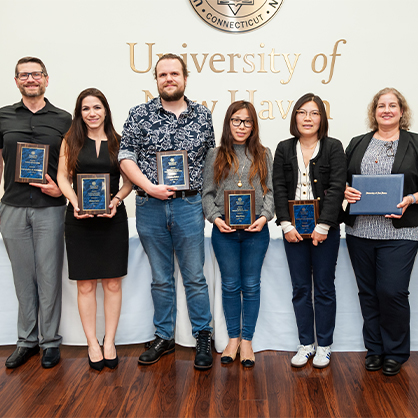Education
Ph.D., Chemical Engineering, Syracuse University
About Huan
In this coming fall, I will join the Tagliatela College of Engineering as a TT Assistant Professor in Chemical Engineering. I will teach CHME 3309 Chemical Engineering Workshop and CHME 3321 Chemical Reaction Engineering. My future research interests are understanding and engineering soft and living materials and their applications in addressing environmental and medical challenges.
In 2014, I graduated from the Department of Biomedical and Chemical Engineering at Syracuse University with a Ph.D. degree in Chemical Engineering. My Ph.D. research focused on understanding and engineering bacterial biofilm formation using chemical and topographical surface modifications. Upon graduation, I received a Postdoctoral Fellowship from the Alfred P. Sloan Foundation to investigate bacterial biofilms in the built environments and their roles in hospital-acquired infections (HAI). During this fellowship, I employed whole-genome sequencing (WGS) and Bioinformatics to investigate how microbes acquire antibiotic resistance during HAI and applied the findings to direct the design of new antifoulings surfaces in the built environment. In 2017, I received an R21 award as a co-Investigator from the National Institutes of Health (NIH) to engineer a bioinspired soft-robotic surface for long-term control of biofilms formation on medical devices. This award directs my research passion to the understanding and engineering soft and living materials and their applications in environmental and medical challenges.
I have been actively involved in organizations to support females' career development. I was a faculty facilitator of the Women in Science and Engineering (WiSE) at Syracuse University. I am currently a committee chair of the Mentoring and Outreaching Committee of an international organization, Graduate Women in Science. I look forward to continuing this after joining the University of New Haven.
Selected Publications
Shang, H.T., Gu, H., Zhang, N., “From traditional to novel treatment of arthritis: A review of recent advances in nanotechnology-based thermal therapy”. Nanomedicine. 2021.10.2217/nnm-2021-0182. https://doi.org/10.2217/nnm-2021-0182.
Lee, S. W., Philips, K., Gu, H., Kazemzadeh-Narbat, M., Ren, D.C, “How microbes read the map: effects of implant topography on bacterial adhesion and biofilm formation”. Biomaterials. 120595. https://doi.org/10.1016/j.biomaterials.2020.120595.
Gu, H., Roy, S., Zheng, X.H., Gao, T., Ma, H.L., Soultan, Z., Fortner, C., Nangia, S., and Ren, D.C., “High-level antibiotic tolerance of a clinically-isolated Enterococcus faecalis strain”. Applied and Environmental Microbiology. 2020. 87(1). DOI: 10.1128/AEM.02083-20.
Gu, H., Lee, S.W., Carnicelli, J., Zhang, T., and Ren, D.C. “Magnetically driven active topography for long-term biofilm control”. Nature Communication. 2020. 2211(11). https://doi.org/10.1038/s41467-020-16055-5.
Gu, H., Lee, S. W., Carnicelli, J., Jiang, Z. W., and Ren, D. C. “Antibiotic Susceptibility of Escherichia coli Changes during Early-Stage Biofilm Formation”. Journal of Bacteriology. 2019. 201(18). pii: e00034-19. DOI: 10.1128/JB.00034-19.

